Fairly recently I decided to stop using single-use plastic to create my artworks to be more green. This sounds quite easy, but in reality it’s quite hard since so much stuff arrives in plastic, and some things don’t exist in refillable form, so I have to hack things or work around them. Case in point is the white fine liner, marker or gel pen. Surely there’s a official refillable version for all those white Posca chalk markers that are busy being used to advertised re-opened pubs across the land?
Nope.
For some weird reason, white isn’t one of the colours you can get in cartridges, and the fountain pen ink is very weak (not that opaque) and the Poscas are some of the worst – they are not officially refillable (Sakura are pretty bad at not making green versions of their pens, like the Pigma Micron). You can refill them with acrylic inks, like I have the brush pen below – it’s not exactly the same. I wish Sakura would make Posca refills, those large 17K markers I use, it’s a crime to throw them away (I don’t).
I have attempted to use Molotow refillable markers and acrylic ink in the past – you can see two of the remnants of that experiment in the photo below.
What happens is the pens gunge up – white ink has to be quite thick to be opaque, but that doesn’t work with pump fine-liners. Thinner ink like fountain pen and indian ink, yes they work great, just not white.
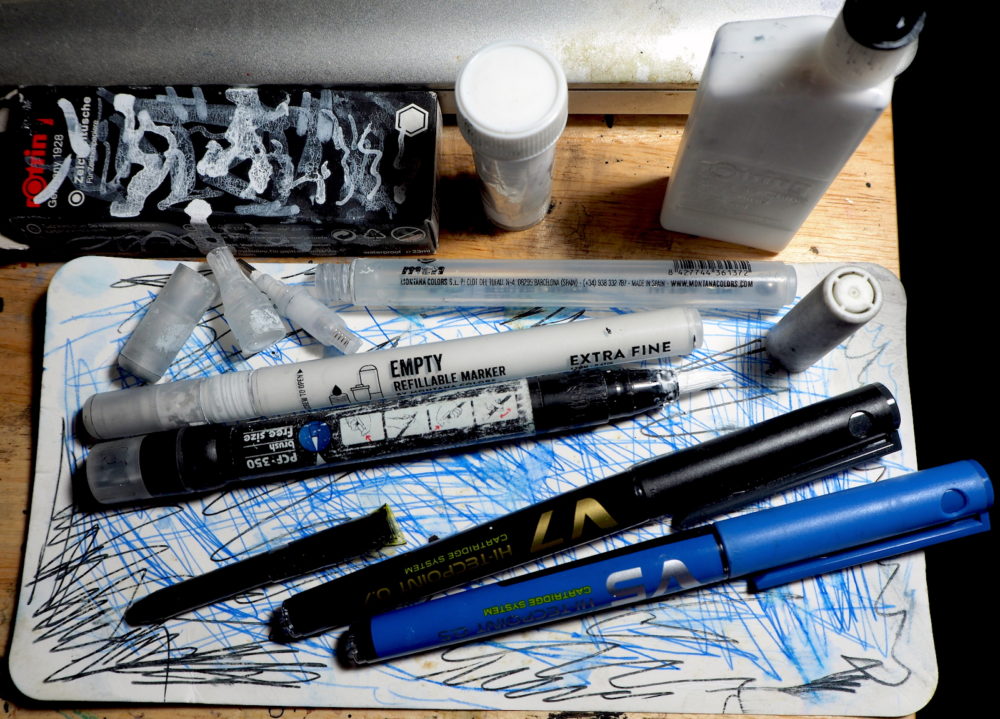
So when I found out that Pilot make a green 71% recycled refillable version of their V5 and V7 Hi-Tecpoint pens, I was up for an experiment. The cartridges are Pilot standard fit – so if you have Parallel Pens those cartridges will fit, as will converters such as the CON-50 and apparently CON-70. So yes you can use fountain pen ink, even eyedropper the pen (that’s pen talk for filling the whole body of the pen with ink – i.e. with an eyedropper or pipette – you can use silicon grease on the threads to seal it from leaking). Or you can re-fill the cartridge with a blunt-end syringe.
Why would you replace the ink in these pens and not use their cartridges? Well three things: cost – bottled ink is way cheaper, and we are trying to avoid using single use plastic anyway – and the fact that the ink in these pens like the Parallel Pens is not waterproof nor archival/lightfast.
So what white ink would be thin enough to work in them but thick enough to be opaque?
I did some research and came up with Rotring White ink – it’s intended for technical pens, so maybe it would work. The first fun thing was when the pens arrived, the cartridges were already in, so I needed to flush the pens as I didn’t want grey or baby blue ink (I bought the blue V5 as black V5s were out of stock on eBay). I thought this might be easy with a water flush, but these pens work by a sort of capillary action. So I had to do what you can do with refilling disposable Pilot Vx pens – pull the rollerball nib and feed (the serrated bit where the ink collects) from the body with pliers. That done, I then flushed the ink out of the feed.
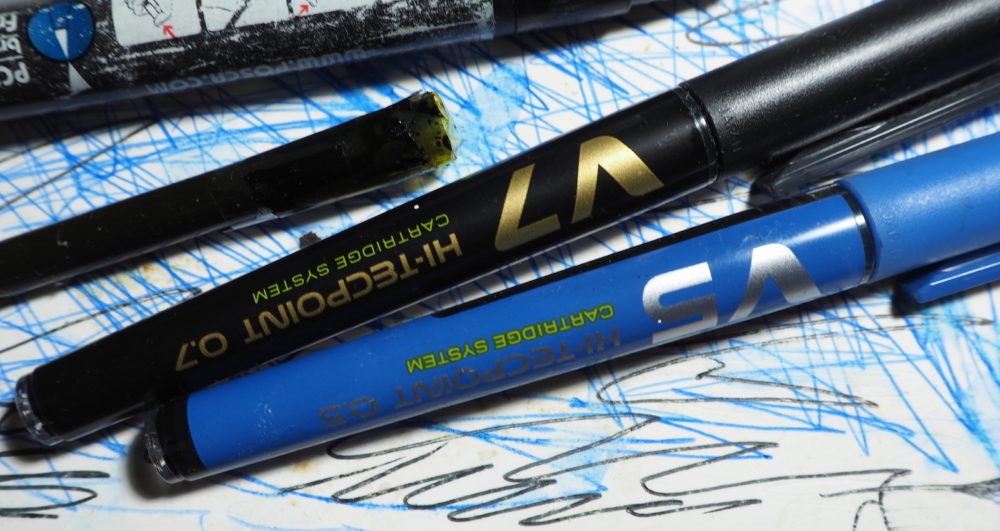
Not Easy Being Green
I then filled the pen with white ink – in the body of the pen (eyedropper)…and had some fun getting the feed and nib back in so the lid would click – you have to press it in hard. And then started scribbling…and scribbling…and scribbling….and no joy. Obviously the ink was too thick – for the V5 anyway! Lots of banging, shaking, flicking and scribbling later, I still had no nice white lines on the paper, just a few ink splat, so ink was getting into the feed, I could see that….just not coming out of the pen.
I tried adding a few drops of washing up liquid – as per the suggestion of the Cult Pen links above – and a drop of water…still no joy. I had to give up and then try and reverse all these things. Getting the tip/nib and feed out a second time was hard – maybe I pressed it in too hard? I filled that and the V7 with Lotte Sketchink – the V5 was recalcitrant, maybe some white ink was left…but the V7 was immediately great. Good flow – and slowly the old water-soluble ink was replaced with the waterproof Lotte (I tested it with a waterbrush).
The V5 though – oh boy. You can see a lot of the scribbles above. there are pages of it – as it slowly went from the blue that had somehow clung on through all those flushes – but eventually went black. With both I was expecting what in the trade are called ‘hard starts’ – i.e. like old Bic pens, you have to scribble a bit to get it to work after not using it for a while. Not had that yet.
So the verdict: yes you can refill these pens with fountain pen ink, and maybe even white fountain pen ink – just not the thicker Rotring white ink. Boo.
No fear though, I remembered the refillable markers mentioned earlier, and put the white ink in those. It works FAR better than acrylic ink, and even found the disused Posca brush pen – which is supposed to be single use, and then cracked it open, cleaned it – this is where my vintage pen cleaning stuff like small pipe brushes came in handy – and refilled it with the Rotring Ink. Works fine.
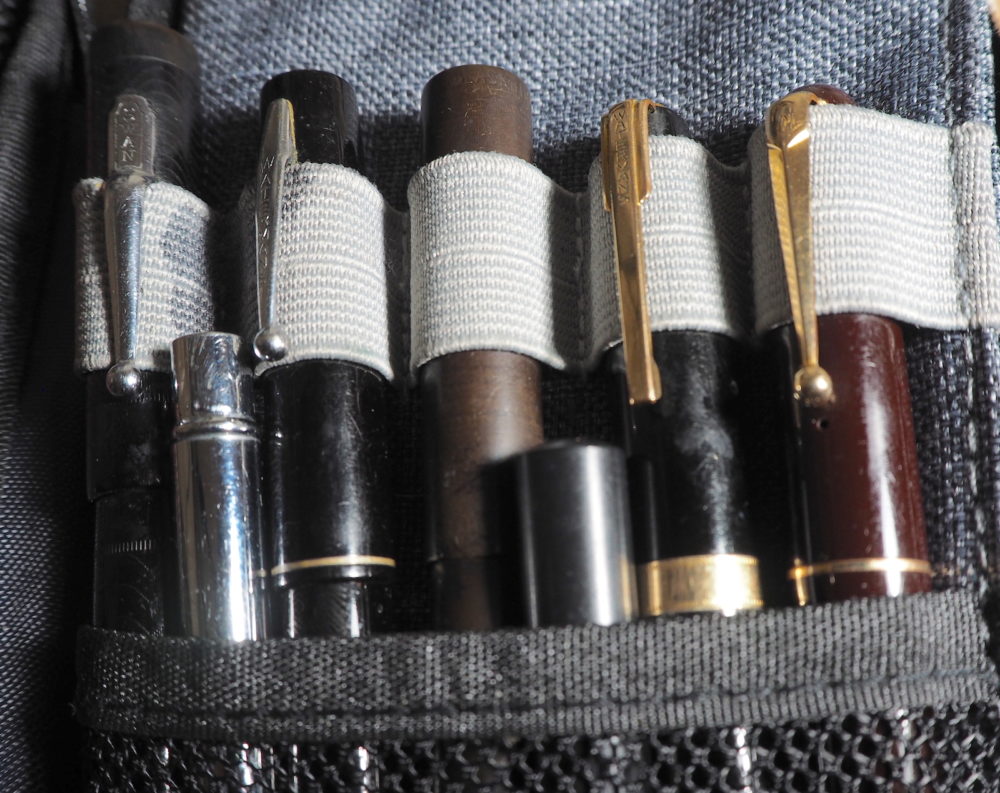
Talking of which – I switched to fountain pen over a year ago to again reduce my use of single plastic pens. What is less convenient is FAR more green and better for the planet (and again, you can choose your own ink and even mix your own colours!) I love them, here are my vintage pens that all but one I refurbished myself.
Very proud of them – nearly all of them are British pens from the 1930’s and 1940’s, one might be 1920’s – the Mabie Todd Blackbird Thin could be earlier as it’s ‘hard rubber’. All are flex pens with gold 14ct nibs. I have a Waterman 32V from Canada as well, my one non-UK vintage pen. Two Mabie Todd Swan pens – SM200/60 which is my favourite as I fixed the nib myself, and 3150, and several unnumbered Waterman WW2 era pens.
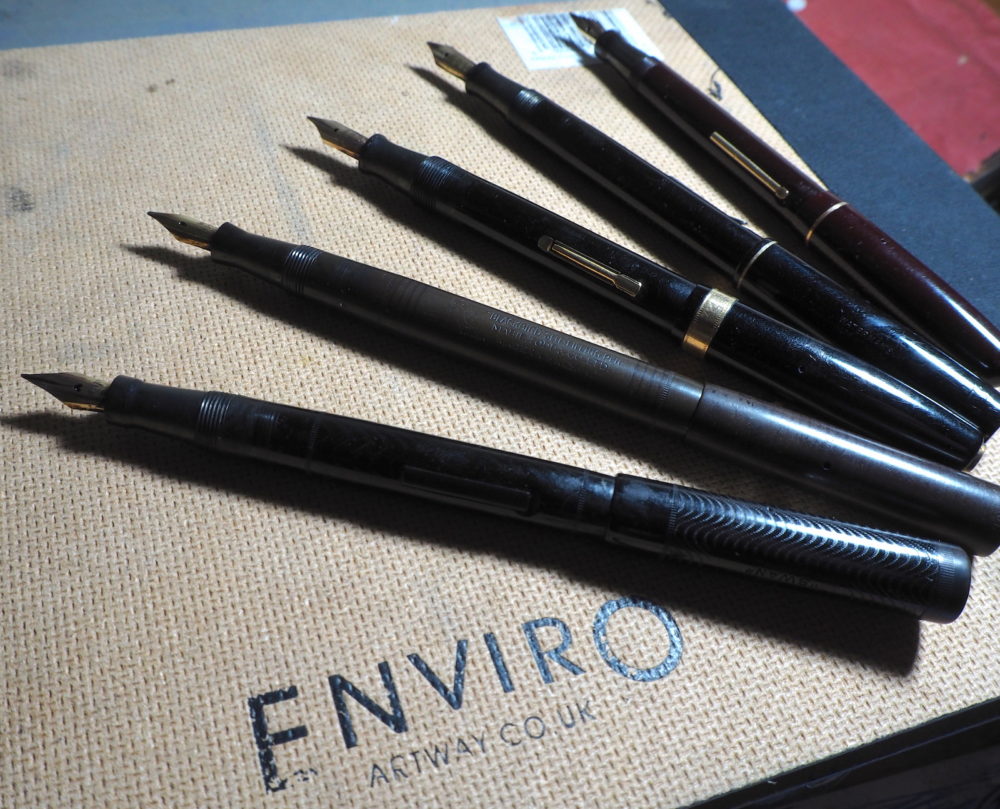
Also pictured here under the pens is my Artway Eco sketchbook – which is brilliant, I’ve been using their 100% recycled 170Gsm cartridge paper for years, and this is made of that with recycled hardboard covers. It is built like a tank, and not that weird off-gray you sometimes get with recycled paper, more of a nice ivory colour. Really recommended.
How Green Is Plastic Actually?
Anyway this isn’t meant to be showing off, but the fact that great cheap vintage flex pens exist and hark back to a time of habitual re-use and recycling. Or even good modern pens like Kaweco or Lamy (if not flex, the good modern flex pen does not exist as I found to my annoyance!). And that unlike say, supermarket plastic waste where some things haven’t been invented to replace them, there IS alternatives for writing and creating art – and have been for hundreds of years.
It’s why although I respect campaigns to end single-use bags, cups, cutlery and supermarket plastic packaging, I wonder where the campaign to stop disposable pens. single use cartridges and single use stationery is? Is that too unpopular? Because actually that is easy…surcharge the manufacturers that make them or ban them from selling single use pens. There are refills – even for biros, but also some much better options – but they are hard to find.
These cartridge Pilot pens? I only found them in one shop in my local town, WHSmiths and I found the last one (annoying because I think they had a 3 for 2 offer and I totally would have bought two). They are weirdly very hard to find in an actual shop. Why? These should be the standard.
That also goes for Sakura Posca and Pigma Microns (disposable), Zebra pens (ditto), Faber Castell and W&N pigment/archival markers – yes also not made of recycled material, single use and aimed at artists! Staedtler Pigment liners, Sharpies etc. It’s a real bugbear of mine that these pens are widespread yet not easily recyclable nor made of recyclable material and not refillable.
I say ban all pens that can’t be refilled, that would solve the problem really quickly – the technology is there, as Pilot and Pentel have proved. Their brush marker uses cartridges and will happily take Rotring and fountain pen ink, as does the Kuretake brush pen I also use.
Obviously a shift to cartridges doesn’t totally solve the problem – it reduces it though because a single plastic cartridge is easier to recycle than a pen with a mixture of metal and different plastic parts. But it also makes it easier to hack the pens to be fully green, or use convertors etc. That would be the ideal, shift back to bottled ink or even maybe if those fashionable refill shops started refilling cartridges and pens for you. Making sure all pens could be refilled would make stuff like that common.
His Green Materials
I’ve been very pen-focused in this blog post – but this also goes into other areas – watercolour for instance. Buying small half or full pans are wasteful and the plastic pans and packaging are thrown away – refilling empty pans with tubes is cheaper and I think better for the environment. I personally don’t work direct from tubes as that tends to lead to wasted paint, but that is also good.
Hardboard or plywood makes a good replacement for expensive canvas-board for acrylic and oil painting, and you can often find it for free in the street/skips or on sites like Trash Nothing/Freegle etc. Just avoid the chemical/oil treated sort. Think like a skint art student, and you’ll be surprised what free and cheap materials are out there to recycle and reuse.
Those small jam pots make great ink and paint holders. I have something I call the ‘rack’ and I’ve been meaning to do a ‘My studio’ post to feature all my art ‘hacks’ and bargains – but for getting the most out of paint tubes it’s indispensable, it’s advertised as a toothpaste tube squeezer and the same thing is sold at art stores for many times more. It works with any metal tube!
It’s all about stopping any waste, and making sure things are used many times – even plastic. I use plastic sample vials for my ink, because the glass ones are too heavy. I make sure I re-use them though. Plastic still has it’s place, just not as single use – like the pens above, most are celluloid or acrylic, used for nearly a hundred years. That is the ideal, get the biggest bang for buck out of the energy cost you can.



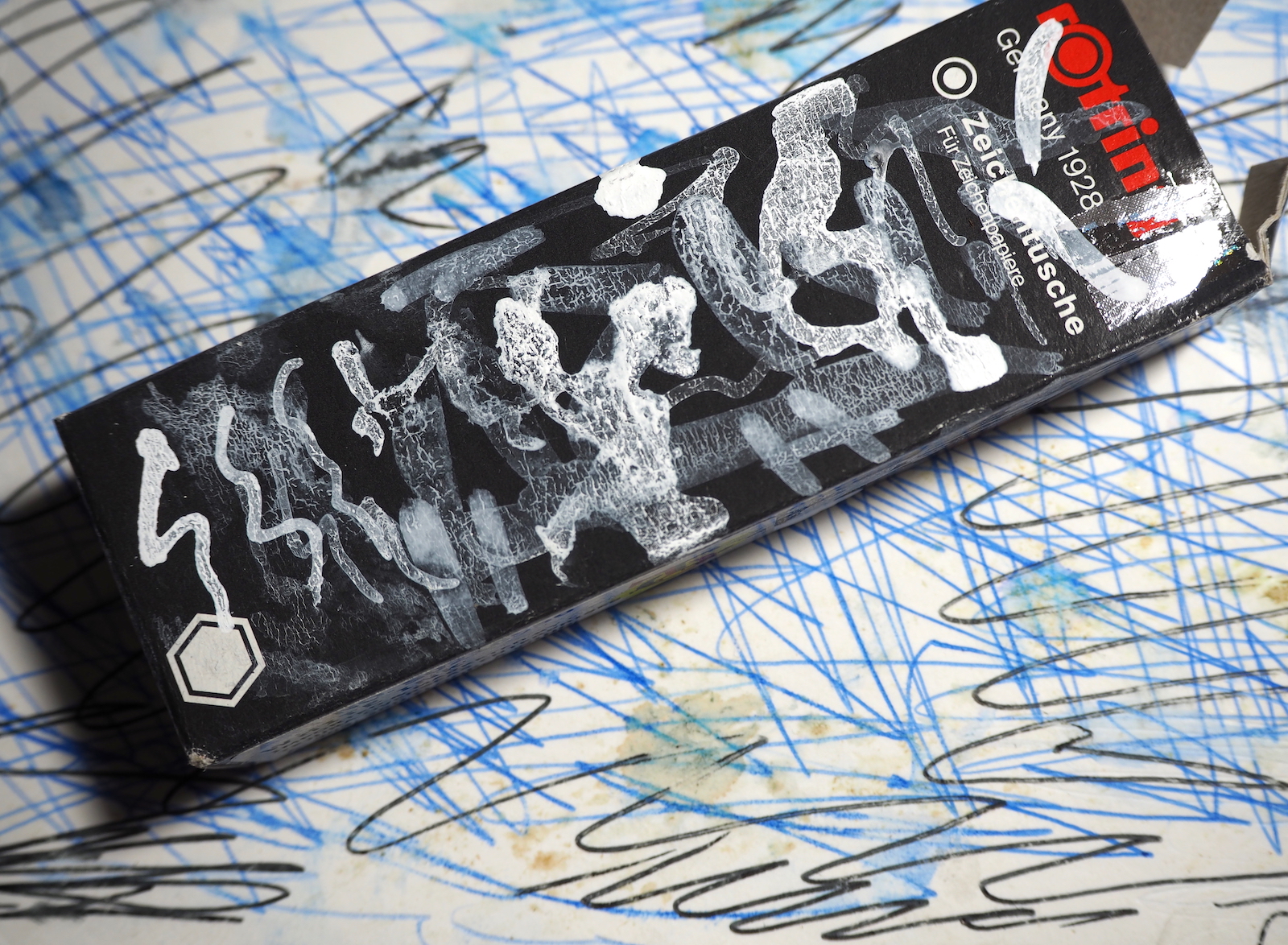
Leave a Comment! Be nice….